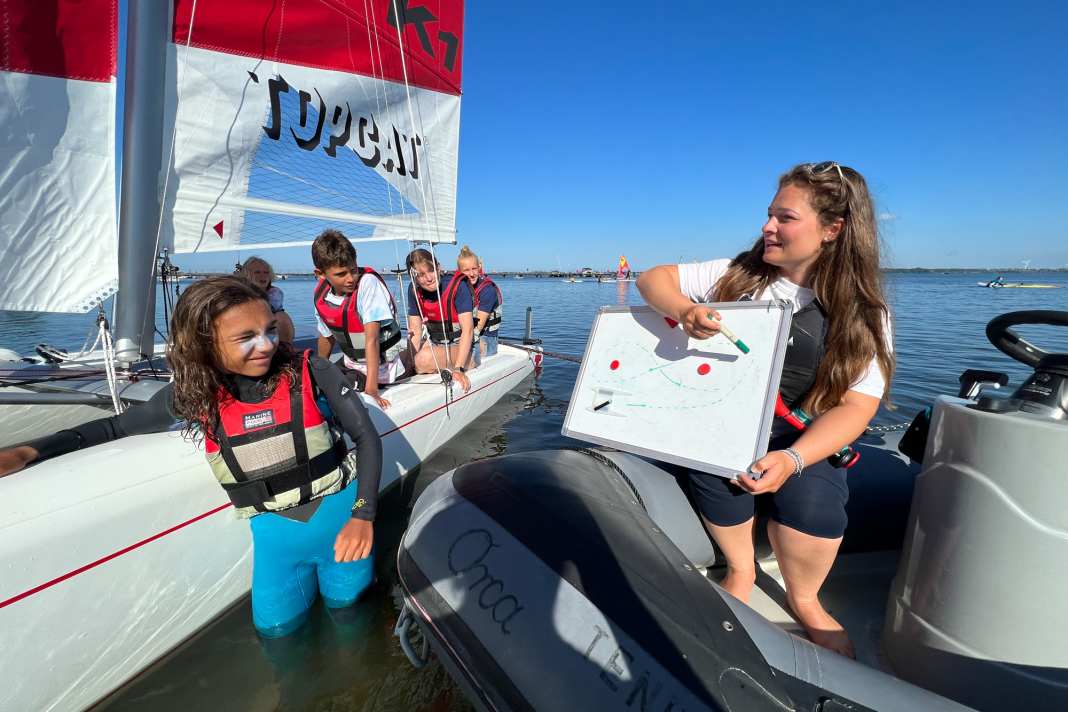



The beach catamarans rush along the Wieker Bodden at an angle towards the wind in a medium breeze. "Remember to hold the jib back when you tack," Paula Farke calls out to a group who are teaching sailing at the Rügen Pirates water sports school in Dranske. The 22-year-old leads the basic course and has to teach her students the most important manoeuvres from casting off to mooring, but above all safe sailing including man overboard and, last but not least, capsizing and righting. She particularly enjoys inspiring children with her wit. "I always have a lot of fun passing on my passion," says Farke, describing her passion for teaching.
The Saarbrücken native from a water sports family became a VDWS sailing instructor a year ago at the same location in Dranske, after she already had almost all other teaching qualifications. The so-called university course, which will be offered again this year at the end of August ( to the course page ), is aimed at instructors with previous teaching and sailing experience and has therefore been shortened from eight to six days. "Anyone who already teaches surfing or kitesurfing courses can also take part," explains Paul Funke, "has completed an internship at a VDWS centre or is active as a trainer in a club." The head of sailing at the Rügen Pirates is part of the VDWS teaching team and trains instructors himself.
What instructors must be able to do
The basic requirement for becoming a VDWS instructor is to be able to sail a dinghy and a catamaran safely in fresh winds of force four to five. After all, these conditions not only prevailed during the course, but can also occur at any time when training newcomers. "It was unusually strenuous. I felt the power in a different way than I usually do when windsurfing," reports Paula Farke. The experience was a real lesson in favour of classic sailing compared to fun sports.
Among the eleven prospective instructors was Siri Webler, who had actually wanted to become a surf instructor after graduating from high school and completing an internship, but then learnt that there was much more demand for sailing. "And it's cooler in light winds," says the 20-year-old from Lüneburg, who was hired as a VDWS sailing instructor on the North Sea island of Föhr over the summer. "Successful training almost guarantees a job, even at sailing schools abroad," says Paul Funke, promoting participation.
Training course to become a sailing instructor
The eight-day course at the end of September in Altefähr at Sail & Surf Rügen ( to the course dates ). The syllabus also includes lesson planning, methods of teaching the material as well as school and lesson organisation, which includes corresponding exercises on topics such as weight and boat trim, steering technique and sailing positions. Seeing mistakes, knowing and recognising the causes and being able to correct them makes a good sailor a good teacher.
"The tips are virtually devoured," says Paula Farke, delighted with the willingness of young and old to learn something new in their free time and develop their own skills. Her role as a teacher has only positive connotations and is respectfully recognised, even by participants who could be her grandfather. As a judo trainer, she has a knack for training and has spent every spare minute on Rügen for eight years, even though she is studying horse management in Dronten in the Netherlands. She repeatedly emphasises team spirit as a particularly motivating factor in her work.
Now that the VDWS has merged the training of instructors for dinghies and catamarans, the incentive is even greater because the subsequent job opportunities are more varied. The courses consist of several parts. Nobody should underestimate the theory and prepare thoroughly via e-learning. The practical exam takes you through a course. Then there are teaching tests, also in theory and practice. Instructors go on the training boat themselves once and must also guide an entire group from the accompanying motorboat.
"The VDWS stands for high quality standards. Our services must be competent at all levels and fulfil ambitious requirements," says Funke. Since its foundation in 1974, more than three million water sports beginners have been trained worldwide. And the demand for sailing licences continues unabated to this day. Two years ago, the association established a new basic licence system and has also been offering one to youngsters ever since.

